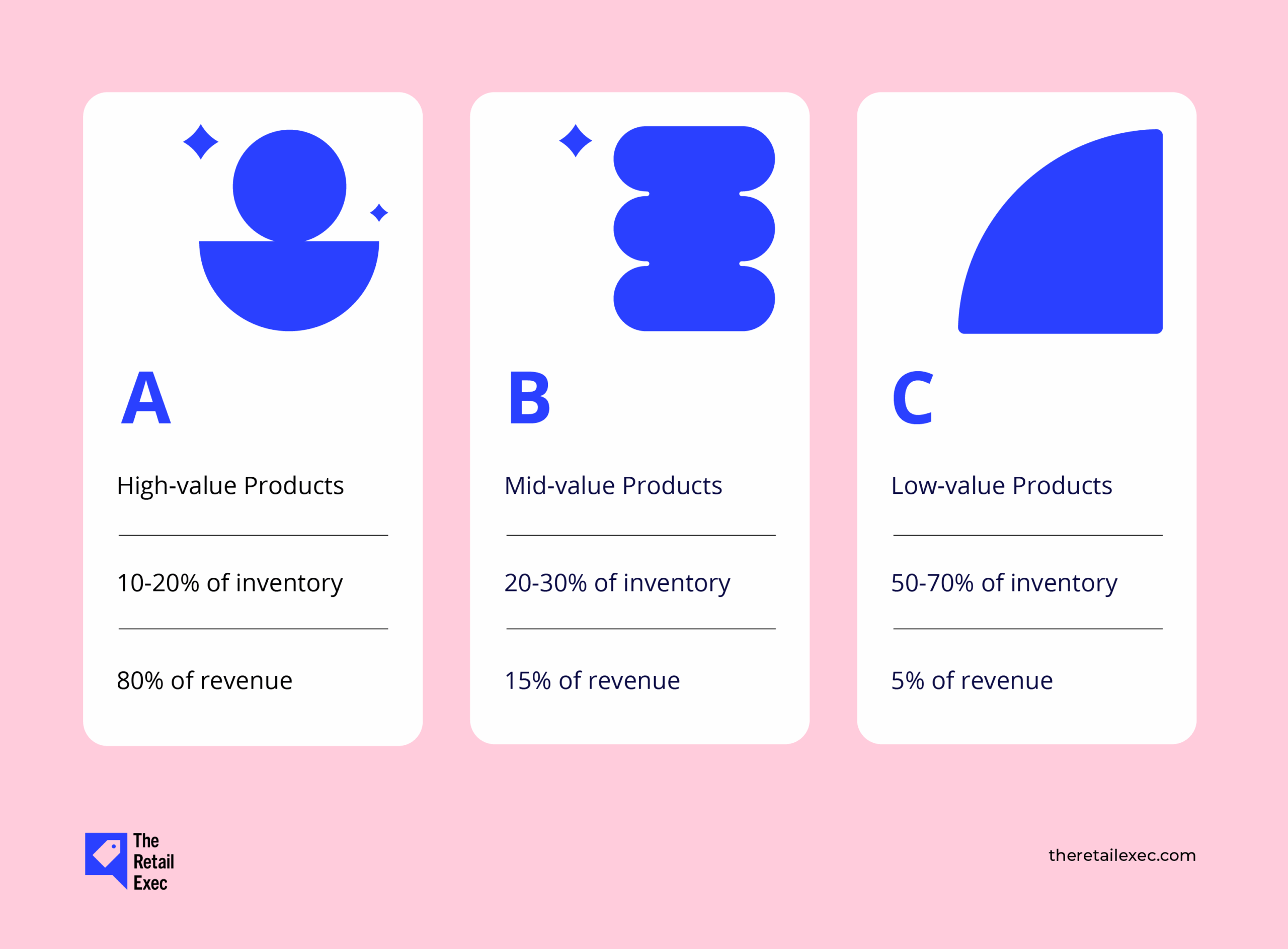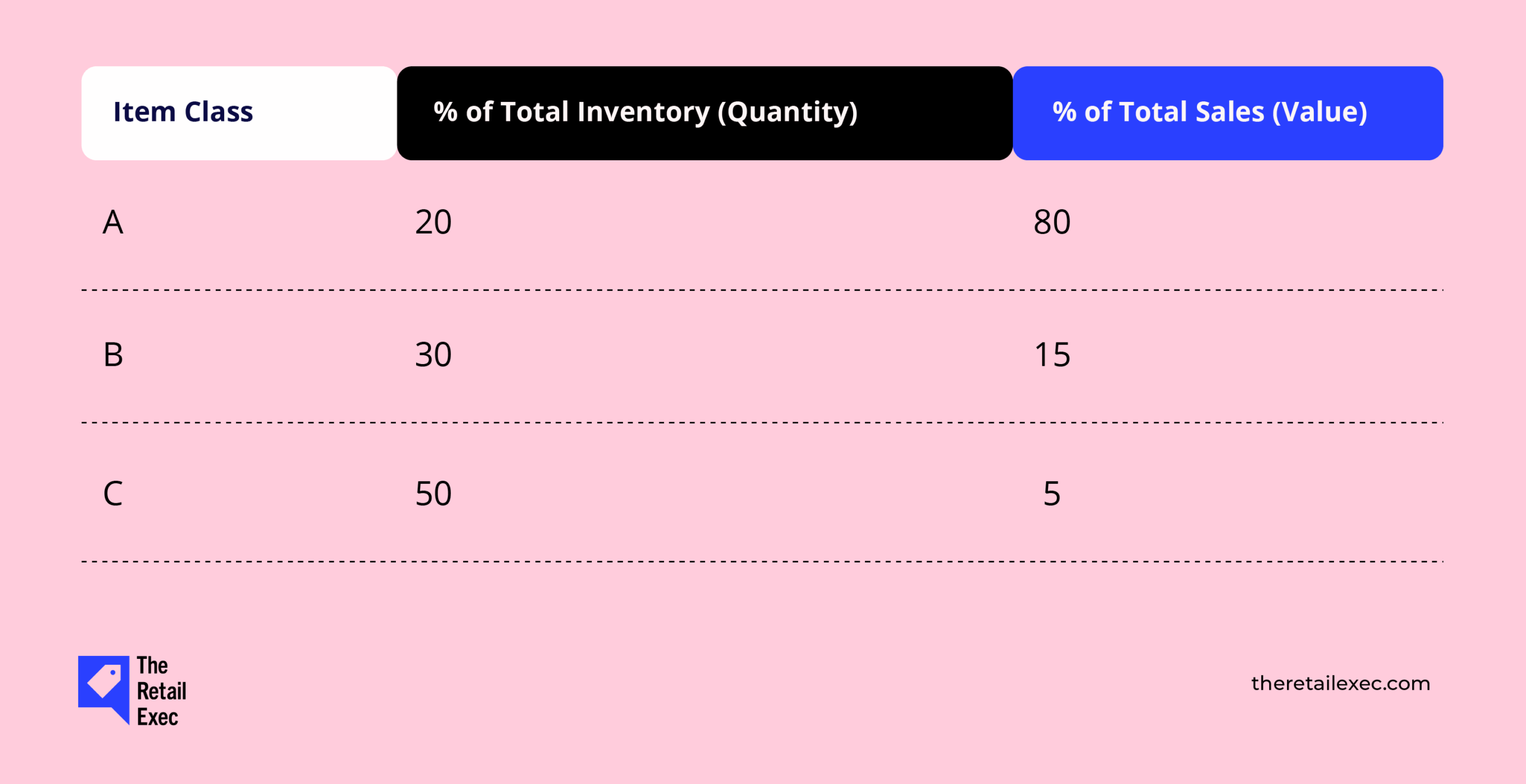The Pareto Principle Wins Again: Inventory management shows that 80% of revenue is driven by just 20% of SKUs, highlighting the necessity to focus on top-performing products.
Wasted Space and Effort, Oh My: An astounding 80% of shelf space and resources drive a mere 20% of revenue, suggesting the need for more efficient inventory strategies.
Inventory Managers, You Are Not Alone: Feeling the frustration of the Pareto imbalance is common among inventory managers, providing some comfort in shared experiences.
Like many other aspects of life, inventory management seems to follow the Pareto Principle. You have a ton of SKUs, yet 80% of your revenue comes from just 20% of them.
While frustrating for inventory managers, it should help to know you aren’t the only one. Do you feel seen now? Good.
Many of us are wasting 80% of shelf space, labor, and logistics to get just 20% of the bottom line. But, that’s not the end of the story (we’re only in the intro!).
ABC inventory analysis can, to a large degree, fix this vexing issue.
In this article, we'll explain how to use ABC analysis, how it works in inventory management, how to calculate and implement the process, and how the right technology can lend a hand.
What is ABC Analysis?
ABC inventory analysis is a method of categorizing inventory into three classes (A, B, and C) based on importance and inventory value to prioritize management and resource allocation.
ABC analysis is a simple approach to a lot of complex management systems. By splitting inventory into three categories—A, B, and C—you can assign them different priorities depending on their importance.
Some excellent inventory management software and enterprise resource planning (ERP) tools can do this analysis for you.
However, the system isn't limited to inventory management or inventory control. An ABC analysis and ABC classification can also be helpful for accounts receivable, personnel management, and warehouse operations.
For that matter, what is XYZ and FSN analysis?
Look, we didn’t set out to make inventory management feel like alphabet soup—but here we are. ABC analysis is just one way to get a handle on your stock.
There are a couple of other handy methods that add depth to your strategy, and while XYZ makes sense alphabetically, FSN feels like someone just mashed the keyboard. Here's the method to the madness:
- XYZ analysis breaks down inventory based on demand predictability:
- X-items sell consistently—no surprises.
- Y-items have some sales patterns but fluctuate (think seasonal surges).
- Z-items are chaos in a box—completely unpredictable.
- FSN analysis focuses on movement speed:
- Fast (F) movers fly off the shelves.
- Slow (S) movers take their sweet time.
- Non-moving (N) items… well, they just sit there, making you question your life choices.
These methods aren’t replacements for ABC—they’re complementary tools.
Pairing them can give you a sharper view of which products are valuable, which are reliable, and which are eating up space for no good reason.
The ABCs of ABC Analysis
To understand why brands use ABC analysis for inventory management, you need to know what these categories mean.

- A-items: These high-value items represent only 10-20% of your stock, but are responsible for 70-80% of your revenue.
- B-items: The middle child of the bunch, these items are 20-30% of your inventory and 15-25% of your sales.
- C-items: The bulk of your inventory at around 50-70%, yet only 5-10% of your sales.
While each category of stock is important, the classification matters for how you approach the management of each across your inventory.
ABC Analysis in Action: An Example
Classification is at the heart of the ABC method.
It works by spreading out all the items in your inventory and ranking them according to their output value. You then separate the highest-value items from the middle and lowest tiers.
Your inventory management software might display the data in any number of ways. Or you could build a simple spreadsheet in Excel that looks like this:

This data gives you a snapshot of the 80/20 rule, and a few things pop out.
Notice the top 20% of items by volume on your shelves make 80% of your sales output. Meanwhile, the bottom 50% only earns 5% of your sales.
It also reveals potential for future revenue growth.
So, say you scaled back your C inventory and gave all that shelf space to more A items. You could see up to a tripling of your return since you'd be moving 2.5 times more high-value inventory.
An example of ABC product categorization
Say you have an online store that sells kitchenwares. You sell a wide variety of small appliances, cookware, and gadgets. You might break up your inventory like so:

- A products: Home espresso machines, stand mixers, rice cookers, food processors, etc.
- B products: Kitchen knives, pots and pans, silverware sets, dutch ovens, etc.
- C products: Gadgets like spatulas, whisks, can openers, ladles, etc.
With this hierarchy in place, you can start implementing strategies for each category that respect the revenue-generating potential for the different types of products.
ABC Inventory Control Strategies by Category
With your inventory broken up into these three distinct categories, you can start devising your strategy for each. Let’s take a look:
- A-items: These require tight inventory control, regular review and cycle counting, and accurate demand forecasting to maintain a stable stock without overordering or enduring stockouts. Example: Stand mixers.
- B-items: Use a more balanced approach for these SKUs, with less frequent cycle counts and a moderate use of forecasting to stay stocked. Example: Saute pans.
- C-items: There’s a lot of leniency here. You can purchase these low-cost items in bulk, store them more efficiently, and prioritize sales for higher inventory turnover. Example: Whisks.
Developing these hierarchical inventory strategies saves you time and puts the priority on what sells best.
By focusing on the number of items in each category, brands can better understand their inventory turnover and develop a more efficient reorder point system. This alone can reduce carrying costs and improve the overall management process.
Maximize the efficiency of your ABC analysis by integrating a perpetual inventory system to maintain accurate data on your A, B, and C items.
How to Calculate ABC Inventory Analysis Step by Step
Getting started with an ABC system to manage your inventory is a three-step process.
Step 1: List your inventory on a spectrum
First, list all your inventory items in a single place. This can be in a spreadsheet or an enterprise inventory management software. Then, rank these items in descending order according to your preferred metric.
Common metrics include:
- Total sales of each item
- Gross margin of each sale
- Purchasing costs
- Holding costs
- Annual consumption value
Step 2: Set boundaries for each category
You have to cut the categories off somewhere, and it's best to set objective criteria for categories A, B, and C beforehand.
For instance, if you're tracking sales, you may consider a high-value item to move more than 1,000 units a month. Or you may set a dollar value at $10,000 a month and above as a category A item.
Set a maximum threshold for a category C item, such as 100 units a month or $1,000 in sales. Anything between these values would be a category B item by default.
You're not trapped inside a strict three-item scale.
Depending on the needs of your business and what information you're interested in, you could use as many categories as you'd like.
ABCDEF inventory analysis?
The table below shows how you might structure your inventory based on total net profit per category, with much finer divisions than a simple ABC model:

Breaking things down into smaller categories has spread out the 80/20 effect quite a bit, but the data is still useful.
In this hypothetical, one category of items, which would have been lumped in with C items, has low profits and low sales volume, earning it an F status.
Note that there is still a broad division between the two top tiers, the two middle tiers, and the bottom two, which are each closer to each other than they are to the other item classes.
Alternately, use annual consumption value
Another way to break your products up is by finding the annual consumption value for each product.
To get that number, you use the following formula: Number of units sold per annum x cost per unit.
After sorting your products in descending order by their annual consumption value, you can split them up by the percentage of your total revenue they represent.
Step 3: Keep an eye on things and reassess
Nothing in inventory management ever stays the same.
As your sales and stock levels evolve, item performance is bound to change. Try to run an ABC inventory analysis at least once a month for every category or data set you're interested in.
Do it weekly if you can.
Never hesitate to alter how you treat different items in your stock based on your most recent inventory analyses.
Most cloud based inventory management software comes with robust reporting—use it to iterate, improve, and learn.
As you embark on this calculation, remember that managing your inventory doesn't stop here. Dive deeper into the complexities of inventory management, including common challenges and solutions.
Benefits of ABC Analysis for Ecommerce Inventory
ABC analysis isn’t just about organizing SKUs—it’s about making smarter moves that grow your bottom line. Here’s how it helps you work leaner, sell smarter, and keep customers coming back.
- Optimize your inventory. See what’s flying off the shelves and what’s gathering dust. Move fast on top sellers, and stop wasting shelf space on slow movers.
- Forecast demand with confidence. Spot trends and predict future inventory needs—no crystal ball required.
- Shift resources where they matter. When customer demand shifts, your ABC categories show it. Reassign staff, storage, and budget to focus on high-impact items.
- Negotiate better with suppliers. Know which SKUs you can’t live without. Use that leverage to secure favorable terms, safety stock, or incentives for your most critical products.
- Manage product lifecycles. Chart how products perform over time—launch, growth, maturity, decline—and make proactive decisions about when to promote, restock, or retire.
- Prioritize your best sellers. Your A-items are moneymakers. Keep them stocked, reorder them in bulk, and never let them run dry.
- Cut the dead weight. Carrying costs add up. Identify low-performing C-items early, and replace them with products that earn their keep.
- Simplify supply chain decisions. Month-over-month ABC data helps you decide when to consolidate suppliers or streamline sourcing for specific items.
- Fine-tune your pricing. If a C-item suddenly surges in demand, raise the price while the iron’s hot and boost your margins.
- Level up customer experience. Your most popular products = your most common support requests. Train your team around these SKUs to keep customers happy and loyal.
Limitations and Challenges of ABC Analysis
ABC analysis sounds fantastic—and it usually is—but it's not all sunshine and easy spreadsheets.
Before diving head-first, watch out for these potential hiccups that could derail your shiny new inventory system.
- Data accuracy dependency. ABC analysis is only as good as your data. Garbage in, garbage out—outdated, inconsistent, or incorrect inventory records can lead to misguided inventory classifications and costly mistakes.
- Static classifications in a dynamic market. Inventory isn't set-it-and-forget-it, and neither is ABC analysis. Customer preferences, market demands, and seasonal trends evolve constantly, quickly making yesterday’s classifications obsolete.
- Tunnel vision on 'A' items. Focusing heavily on your high-value inventory makes sense, but don't ignore your 'B' and 'C' categories. Individually, they seem less impactful—but collectively, they could silently drain your resources or hide untapped opportunities.
📌 Actionable solutions:
- Audit your data regularly. Use reliable inventory management software with built-in auditing features, ensuring your ABC classifications stay accurate.
- Schedule quarterly reviews. Regularly revisit and adjust your classifications to stay aligned with market shifts and customer trends.
- Set clear inventory targets across categories. Establish performance goals for 'B' and 'C' items—not just your top-tier products—to capture missed efficiencies and maximize overall profitability.
Industry Applications of ABC Analysis
ABC analysis isn’t just for retailers playing whack-a-mole with stock-outs—it's a versatile tool that works its magic across various industries. Here’s how different businesses put ABC analysis into action to boost efficiency, profitability, and customer satisfaction.
- Manufacturing. ABC analysis helps manufacturers prioritize raw materials and components, keeping production lines humming. By identifying critical ("A") materials that directly impact production, manufacturers reduce costly downtime and streamline procurement.
- Retail and ecommerce. Inventory moves fast in retail—sometimes too fast. ABC analysis allows you to track turnover rates, adjusting your buying strategies based on actual demand. Focus your resources on top-selling SKUs, reducing waste and preventing dreaded overstocks.
- Pharmaceuticals and healthcare. Ever wonder how hospitals manage endless supplies of medication, equipment, and consumables? ABC analysis keeps critical life-saving items stocked without tying up resources in less essential supplies, enhancing patient safety and operational efficiency.
- Food and beverage. Freshness counts—literally. ABC analysis helps restaurants and grocery chains manage perishables effectively, ensuring top-shelf products stay fresh, waste is minimized, and margins remain healthy.
Top Tools for More Effective ABC Analysis
With the advent of modern warehouse and inventory management technology, ABC analysis has become so much simpler.
No more relying on basic spreadsheets and manual data entry to get started!
By automating the categorization process and surfacing real-time insights, these tools allow ecommerce brands to move faster on ABC analysis implementation.
Let’s look at the technology that can help:
- Inventory management software. Highly advanced inventory systems do much more than simple stock tracking. Of their many benefits, inventory software has features like automatic reordering, real-time sales and inventory tracking, demand forecasting, and automatic categorization based on ABC criteria.
- Analytics and reporting tools. These tools, usually a part of a larger platform, help you analyze sales trends, forecast product demand, and identify inventory issues early on. This enables brands to see when products are shifting categories (from B to A, for instance).
- Integrations with other business systems. When your systems integrate, they can seamlessly share and use data to perform more efficiently. So, your accounting software, inventory management system, ERP, and ecommerce platform can work together to improve your stock management, financial outlook, order fulfillment, and ultimately, customer satisfaction.
With the right tech, ABC categorization is an ongoing process, enhancing how you treat every SKU to maximize efficiency and revenue.
Of course, finding the right inventory management solution is the hard part. Unless you have a handy list of the best ones:
ERP Integration: Scaling ABC Analysis for Enterprise
If you're juggling thousands of SKUs across multiple channels—or you just outgrew your trusty standalone inventory tool—it's time to bring out the big guns: ERP integration.
Enterprise resource planning (ERP) systems take ABC analysis to a whole new level, seamlessly embedding it into your broader business processes.
Forget manual data imports and late-night spreadsheet nightmares—ERPs integrate ABC insights right where you manage purchasing, forecasting, and fulfillment.
Here’s why bigger ecommerce operations swear by ERP-driven ABC analysis:
- Real-time visibility at scale. ERPs offer live inventory updates across multiple warehouses and channels, automatically refreshing your ABC categories to keep pace with rapidly shifting demand.
- Advanced automation. ERPs automate purchasing, replenishment, and classification tasks based on ABC criteria, saving you serious hours (and probably a headache or two).
- Unified inventory insights. By connecting ABC analysis to accounting, procurement, sales, and logistics data, ERPs help you make smarter, coordinated decisions—from sourcing to fulfillment—maximizing margins along the way.
- Customizable reporting. Dive deep with tailored analytics showing category-specific performance, warehouse optimization, and supplier effectiveness—without leaving your ERP dashboard.
📌 Quick ERP integration tips:
- Clearly define ABC classification criteria within your ERP to automate categorization accurately.
- Opt for ERPs known for strong integrations with inventory and ecommerce tools (bonus points if they're cloud-based).
- Schedule regular checks of your ERP data quality to keep your ABC analysis razor-sharp.
With ERP integration, ABC analysis becomes a streamlined, integral part of your inventory strategy—giving you smarter, scalable inventory control as your ecommerce business grows.
Advanced ABC Analysis Strategies
Once you've nailed the ABC analysis basics, it's time to push the envelope—because why settle for "good enough" inventory when you can have seriously great inventory? Here are a few advanced tactics that’ll take your ABC analysis from useful to unstoppable.
Implement ABC cycle counting for more accurate inventory
Counting your entire inventory in one exhausting go isn't just inefficient—it’s borderline medieval. A smarter move? ABC cycle counting.
This approach breaks your counts into manageable chunks based on product priority:
- A-items (monthly): Your highest-value, fastest-moving items—count them monthly to minimize costly discrepancies.
- B-items (quarterly): These moderately important products can be accurately tracked with quarterly counts, balancing efficiency with accuracy.
- C-items (biannual/annual): Your lowest-value items require less attention—schedule counts semi-annually or annually.
Quick implementation:
Integrate cycle-count reminders into your inventory software to automate scheduling and eliminate manual tracking.
Use dynamic ABC analysis to respond faster to market shifts
Static inventory categories aren’t great in a dynamic market—customers are fickle, demand fluctuates, and trends come and go overnight.
Dynamic ABC analysis solves this by continuously updating product categories based on real-time sales and market data. If a “C” item suddenly goes viral, your analysis instantly flags it for more attention.
- Set automated triggers in your inventory system to regularly update ABC classifications based on recent sales data (weekly or monthly).
- Use alerts to notify your team whenever items shift categories significantly, prompting quick action on purchasing or marketing.
Combine ABC analysis with JIT or EOQ to maximize efficiency
Why stop at ABC alone? Boost your inventory management even further by pairing ABC analysis with proven strategies like just-in-time (JIT) inventory or economic order quantity (EOQ):
- ABC + JIT: Apply JIT inventory principles to your "A" category—ordering smaller quantities more frequently to reduce inventory costs without sacrificing product availability.
- ABC + EOQ: Calculate optimal reorder points and quantities specifically for your A-items, balancing order costs with holding costs to maintain inventory efficiency and cash flow.
Using these advanced strategies, ABC analysis becomes more than just a categorization method—it’s your secret weapon for maximizing profitability, managing resources smarter, and staying responsive in an ever-changing market.
Turn ABC Inventory Analysis into Your Ecommerce Superpower
ABC inventory analysis isn’t just another dry inventory tactic—it's your secret weapon to cut through the chaos of managing hundreds (or even thousands) of SKUs.
By sorting products into three simple buckets—your all-star earners (A-items), steady supporters (B-items), and underrated workhorses (C-items)—you instantly know where to invest your time, money, and attention.
A-items deserve extra love because they're your biggest revenue drivers, even if they don’t always fly off shelves. B-items quietly pull their weight, consistently performing without much fuss. And C-items, though less glamorous, keep your store running smoothly and efficiently, offering those sneaky opportunities for quick wins.
With ABC analysis at your fingertips—and the right inventory tools backing it—you stop guessing and start managing inventory based on real insights.
You’ll optimize your cash flow, eliminate waste, fine-tune your reordering strategies, and ensure your customers never face the dreaded “out of stock” message.
Simply put, ABC inventory analysis isn't just about inventory—it's about running a smarter, leaner, and ultimately more profitable ecommerce business.
Now go forth and categorize.
Sign up for The Retail Exec newsletter to ensure you get all the latest insights about managing your brand, selling your products online, and boosting your results.
ABC Analysis FAQs
The final thing is the lingering questions banging around your brain. We consulted our crystal ball to figure out those questions, then endeavored to answer them.
How often should I update my ABC classifications?
At minimum, revisit your ABC categories quarterly. If you’re dealing with a rapidly changing market or trending products, monthly updates are better. Keeping it fresh means your analysis stays relevant—no dusty data allowed.
Can small businesses benefit from ABC analysis, or is it only for large companies?
Absolutely! Even if you’ve got fewer SKUs, ABC analysis helps small businesses maximize every dollar spent on inventory. In fact, smaller ecommerce brands can see results faster because every product choice has a bigger impact.
What's the main difference between ABC and XYZ analysis?
ABC sorts your inventory based on value and profitability, while XYZ analysis categorizes products based on predictability of demand. Combining both gives you a powerful picture—showing you what’s valuable and how reliably it sells.
Does ABC analysis work with dropshipping businesses?
Yep! Dropshippers might not physically stock products, but ABC analysis still helps identify top-performing SKUs to prioritize in marketing efforts or supplier relationships. It’s less about physical inventory, more about optimizing product strategy and profits.


